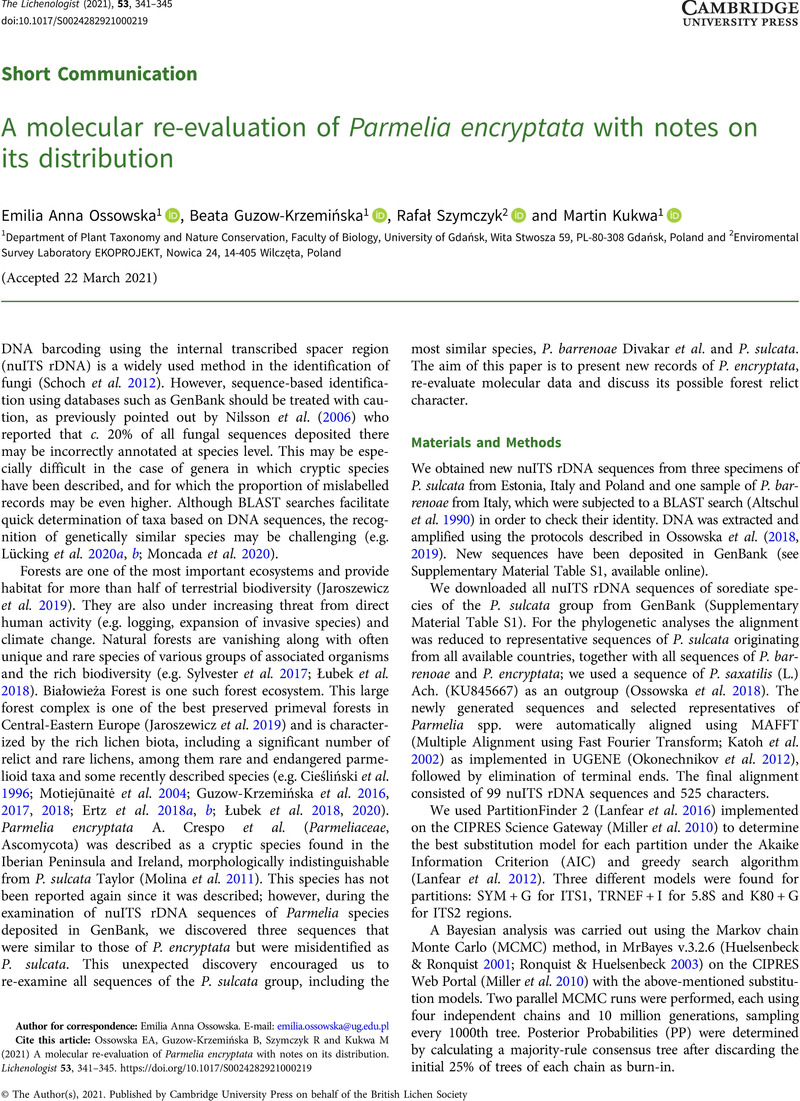Crossref Citations
This article has been cited by the following publications. This list is generated based on data provided by Crossref.
Ossowska, Emilia Anna
Schiefelbein, Ulf
Szymczyk, Rafał
and
Kukwa, Martin
2023.
Contribution to the knowledge of the distribution of <i>Parmelia</i> species (Parmeliaceae, Ascomycota) – New records confirmed by molecular data.
Acta Mycologica,
Vol. 58,
Issue. ,
p.
1.
Ossowska, Emilia Anna
Guzow-Krzemińska, Beata
Kukwa, Martin
Malíček, Jiří
Schiefelbein, Ulf
Thell, Arne
and
Kosecka, Magdalena
2024.
The application of haplotypes instead of species-level ranks modifies the interpretation of ecological preferences in lichen symbiont interactions in Parmelia.
Scientific Reports,
Vol. 14,
Issue. 1,
Szczepańska, Katarzyna
Kukwa, Martin
and
Ossowska, Emilia Anna
2024.
<i>Aspicilia fluviatilis</i> and <i>Circinaria leprosescens</i>, two lichen species of the family Megasporaceae new to Poland.
Acta Mycologica,
Vol. 59,
Issue. ,
p.
1.
John, V.
and
Printzen, C.
2025.
Parmelia Encryptata New for Germany, and Notes on Distinguishing Features of this Semi-Cryptic Species.
Acta Botanica Hungarica,
Vol. 67,
Issue. 1-3,
p.
87.
Dong, Wei
Hyde, Kevin D.
Jeewon, Rajesh
Karunarathna, Samantha C.
Zhang, Huang
Rossi, Walter
Leonardi, Marco
Kezo, Kezhocuyi
Kaliyaperumal, Malarvizhi
Shu, Yong-Xin
Yang, Chun-Lin
Wang, Fei-Hu
Liu, Feng
Ma, Jian
Zhang, Jing-Yi
Lu, Yong-Zhong
Abdel-Wahab, Mohamed A.
Leão, Ana F.
Custódio, Fábio A.
Condé, Thiago O.
Pereira, Olinto L.
Liao, Chun-Fang
Zhao, Hai-Jun
Xu, Rong-Ju
Zhao, Qi
Du, Tian-Ye
Tibpromma, Saowaluck
Monkai, Jutamart
Lumyong, Saisamorn
He, Shu-Cheng
Bundhun, Digvijayini
Yang, Yu
Xiao, Yuanpin
Tennakoon, Danushka S.
Han, Li-Su
Dai, Dong-Qin
Li, Hua
Yang, Yunhui
Manawasinghe, Ishara Sandeepani
de Silva, Nimali I.
Calabon, Mark S.
Ren, Guang-Cong
Wei, De-Ping
Wen, Ting-Chi
Tang, Xia
Armand, Alireza
Jayawardena, Ruvishika S.
Singh, Raghvendra
Rajwar, Soumyadeep
Kumar, Shambhu
Yang, Yan-Yan
Tarafder, Entaj
Acharya, Krishnendu
Shen, Hong-Wei
Luo, Zong-Long
Liu, Jian-Wei
Yu, Fu-Qiang
Li, Yan-Xia
Chen, Yanpeng
Maharachchikumbura, Sajeewa S. N.
Mahadevakumar, Shivannegowda
Sarma, Pullabhotla V. S. R. N.
Danteswari, Chalasani
Podile, Appa Rao
Chandranayaka, Siddaiah
Abdollahzadeh, Jafar
Amirashayeri, Pezhman
Piri Kakihai, Sodabeh
Bashiri, Samaneh
Karpowicz, Filip
Glejdura, Stanislav
Kunca, Vladimir
Ronikier, Anna
Ronikier, Michał
Rutkowski, Ryszard
Mleczko, Piotr
Suwannarach, Nakarin
Kumla, Jaturong
Senwanna, Chanokned
Gafforov, Yusufjon
Sanna, Massimo
Mua, Alberto
Porcu, Giuseppe
Casula, Marco
Rinaldi, Andrea C.
Mohammadi Hamidi, Leila
Ahmadpour, Abdollah
Ghosta, Youbert
Oset, Magdalena
Kukwa, Martin
Guzow-Krzemińska, Beata
Usman, Muhammad
Khalid, Abdul Nasir
Ossowska, Emilia Anna
Kosecka, Magdalena
Miller, Steven L.
Henkel, Terry W.
Aime, M. Catherine
Kaygusuz, Oğuzhan
Bandini, Ditte
Piepenbring, Meike
Kabdraisova, Aisulu
Svantesson, Sten
Ferreira, Renato Juciano
Martín, María P.
Baseia, Iuri Goulart
Kiss, Levente
Tan, Yu Pei
Vaghefi, Niloofar
Shivas, Roger G.
Chen, Li-Jia
Cheng, Song-Qi
Liang, Yu-Shan
Chen, Liu-Huan
Chellapan, Naveenkumar
Arumugam, Elangovan
Vasan, Vigneshwari
Subramani, Priyadarshini
Murugadoss, Ramesh
Afshari, Naghmeh
Gomdola, Deecksha
Sun, Ya-Ru
Abeywickrama, Pranami D.
Gao, Ying
de Farias, Antonio Roberto Gomes
Gui, Heng
Suduri, Leila
Javan-Nikkhah, Mohammad
Hashemlou, Esmaeil
Tian, Xing-Guo
Velez, Patricia
Hernandez-Monroy, Abril
Gasca-Pineda, Jaime
Dissanayake, Asha J.
Chaiwan, Napalai
Wu, Na
Senanayake, Indunil Chinthani
and
Doilom, Mingkwan
2025.
Fungal diversity notes 2017–2122: taxonomic and phylogenetic contributions to freshwater fungi and other fungal taxa.
Fungal Diversity,



